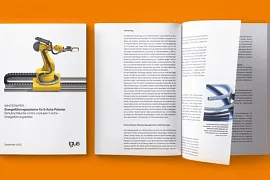Change Language :

Corrugated hose vs. triflex® R: pros and cons
The comparison, competition or, in this case, exchange of blows is as old as human history. The first documented fistfights took place as early as 3000 BC and even then were mainly for entertainment.
The product comparison between the corrugated hose and the triflex® R energy chain is still very recent in comparison. It is true that the focus is not on entertainment, as it is fought with industrial objectivity. However, this objectivity means that a certain toughness is sometimes an advantage.
The duel lasts eight rounds and is therefore midway between an Olympic boxing match with three rounds and a heavyweight fight with 12 rounds.
Fun fact before we get started: the longest boxing match in history went over 110 rounds and lasted 7 hours. In contrast, these eight videos are much more entertaining.
Clear the ring.
Introduction of the opponents
The corrugated hose and triflex® R chain have been duelling over eight interesting and varied laps
Round 1: Elongation
How do both products behave under tensile strain?
corrugated hose
- Stretches strongly under tensile strain
- The cables in the corrugated hose cannot elongate in the same ratio and are therefore damaged
triflex® R e-chain®
- triflex® R chain stretches only minimally under tensile strain
- No additional load for the cable
Round 2: Defined minimum bend radius
Is there a limit to bending?
corrugated hose
- Offers no minimum bending radius without e-rib
triflex® R e-chain®
- Offers a bend radius of 50 to 182 mm in every size
Round 3: Sagging
What happens if the product is bent too much?
corrugated hose
- Damage to the corrugated hose due to underbending and possible damage to the cable
triflex® R e-chain®
- The stop-dog prevents the e-chain® from being bent under
Round 4: Torsion
What happens when torsional forces occur?
corrugated hose
- No or hardly any torsion possible
triflex® R e-chain®
- 7-12.5° torsion angle per chain link
- Up to 900° torsion angle over one metre (e.g. TRC/TRE.40)
Round 5: Filling cables without connectors
What options are there for pulling in cables?
corrugated hose
- filling via the end of the hose possible
triflex® R e-chain®
- filling via the ends of the e-chain® with restriction due to the high tensile strength centre element
- The TRE, TRL & TRCF also offer the option of filling from the outside
Round 6: Filling with harnessed cable
How can cables with connectors be processed?
corrugated hose
- If the connector is not too large, the cable can be pushed through from the ends
triflex® R e-chain®
- With the TRE, TRL, TRLF & TRCF, cables with connectors can be pressed in from the outside
- The TRC chain is much more limited compared to the corrugated hose
Round 7: Shortening and elongation
What options are there for adjusting the length?
corrugated hose
- Can only be shortened with a tool (knife), which poses a risk to hands and cable
triflex® R e-chain®
- Length can be partially adjusted with or without tools
- Can be extended again by fitting chain links, which is not possible with the corrugated hose
Round 8: Replacement after damage
How can damaged areas be treated?
corrugated hose
- It is not possible to replace damaged areas
triflex® R e-chain®
- Damaged chain links can be replaced even when filled

Here you will find the triflex® R TRE e-chain® tested in the comparison videos. The TRE.60.087.0.B was used in the test.
To the shop
In line with the match-up, you can find out about the advantages and disadvantages of the corrugated hose and the triflex R chain on robots in the white paper.
Go to downloadConsulting
I look forward to answering your questions

Shipping and consultation
In person:
Monday to Friday from 8:30am - 5.30 pm.
Online:
24h
WhatsApp-Service:
Monday - Friday: 8:30am - 5.30 pm.